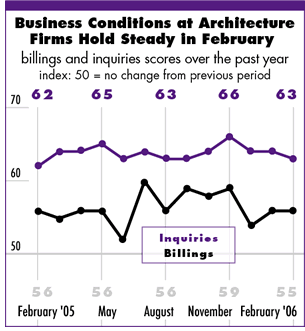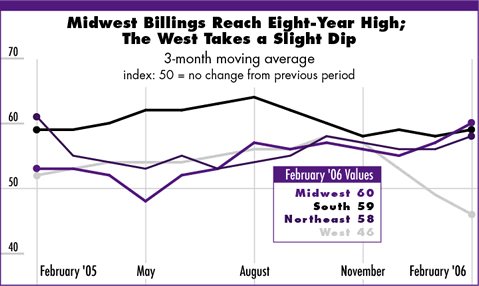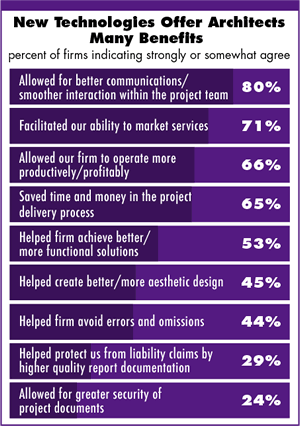

3/2006
Improved team communications at top of tech benefits


by Jennifer Riskus
Guest Economics Editor
 Business
conditions at U.S. architecture firms held steady in February. The AIA
Architecture Billings Index (ABI) score remained unchanged from January
at 55.5, meaning that billings are still increasing at a steady pace
(any ABI over 50 indicates growth). Billings should begin picking up
further in March as the warmer weather triggers the start of many new
projects. Growth in inquiries slowed slightly this month, down a point
from January to 63.4, but continues strong overall, reinforcing the expectation
of more projects in the pipeline in coming months.
Business
conditions at U.S. architecture firms held steady in February. The AIA
Architecture Billings Index (ABI) score remained unchanged from January
at 55.5, meaning that billings are still increasing at a steady pace
(any ABI over 50 indicates growth). Billings should begin picking up
further in March as the warmer weather triggers the start of many new
projects. Growth in inquiries slowed slightly this month, down a point
from January to 63.4, but continues strong overall, reinforcing the expectation
of more projects in the pipeline in coming months.
Regionally, only the West posted a decline this month, marking the fourth month in a row it has fallen as it reaches its lowest score since January 2005. However, all other regions continue to post gains, with the Midwest climbing to 60.3, its highest score in over eight years. In terms of building types, the institutional sector was the only one to post a decline in February, just barely falling below 50 to 49.9. The other sectors maintained their scores from January.
Employment stays strong, confidence dips slightly
National employment gains were strong in February as national payrolls
grew again. Some 243,000 new jobs were added, the largest one-month
increase since November 2005. And, although the construction payrolls
added 41,000 new jobs this month, that is still 10,000 fewer than the
number of construction jobs that were added one year ago. Construction
payrolls should begin ramping up soon in preparation for the summer
construction season.

On the other hand, consumer confidence, as reported by the Conference Board, fell in February for the first time since October 2005. Consumers still have confidence in the present situation, but their outlook for the future is less rosy, and that confidence rating deserves monitoring lest it continue to fall in 2006.
Firms embrace technologies for design
As technology has improved rapidly over the last several years, architecture
firms have embraced it to assist their businesses in various ways.
Common uses of technology at firms include CAD, Web sites, communication
systems, intranets/electronic document sharing, Internet research,
and building information modeling.
 As
architecture firms have increased their use of technology in recent years,
there are numerous perceived benefits of technology for the design process.
AIA Work-on-the-Boards panel members indicated that technology’s
biggest benefit is that it has allowed for better communications/smoother
interaction within the project team (81 percent strongly or somewhat
agree). Additionally, 71 percent strongly or somewhat agreed that technology
has facilitated their ability to market services, and 66 percent strongly
or somewhat agreed that technology allowed their firm to operate more
productively/profitably.
As
architecture firms have increased their use of technology in recent years,
there are numerous perceived benefits of technology for the design process.
AIA Work-on-the-Boards panel members indicated that technology’s
biggest benefit is that it has allowed for better communications/smoother
interaction within the project team (81 percent strongly or somewhat
agree). Additionally, 71 percent strongly or somewhat agreed that technology
has facilitated their ability to market services, and 66 percent strongly
or somewhat agreed that technology allowed their firm to operate more
productively/profitably.
In addition, 65 percent of panelists strongly or somewhat agreed that technology has saved time and money in the project delivery process, but many fewer agreed that technology has helped their firm with project documentation and security.
When asked to select which one benefit of technology was of the greatest benefit to the design/building profession, almost half of the panelists (46 percent) felt that technology allowed for better communications/smoother interaction with the project team, followed by “allowed our firm to operate more productively/profitably” (17 percent), and “saved time and money in the delivery process” (15 percent).
Copyright 2006 The American Institute of Architects.
All rights reserved. Home Page ![]()
![]()
This month,
Work-on-the-Boards participants are saying:
• It’s getting tougher and tougher to find help with 3-10
years experience.
• The region’s economy is growing, and everyone seems busier.
The larger, more high-profile projects are going to the firms from the
larger cities in the region, and the smaller “meat and potatoes” projects
are going to the smaller local firms.
• Business remains robust—lots of project leads have
surfaced in the last month.
![]()